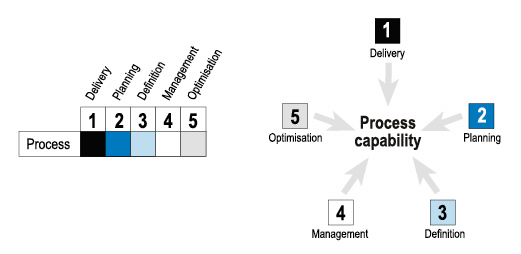

E-Learning Maturity Model
Version Two Process Dimensions
A key development that arose from the evaluation of the first version of the eMM is that the concept of levels used was unhelpful (Marshall and Mitchell, 2006). The use of levels implies a hierarchical model where capability is assessed and built in a layered way. The key idea underlying the dimension concept in contrast, is holistic capability. Rather than the model measuring progressive levels, it describes the capability of a process from synergistic perspectives. An organization that has developed capability on all dimensions for all processes will be more capable than one that has not. Capability at the higher dimensions that is not supported by capability at the lower dimensions will not deliver the desired outcomes; capability at the lower dimensions that is not supported by capability in the higher dimensions will be ad-hoc, unsustainable and unresponsive to changing organizational and learner needs.
In thinking about the relationship between the dimensions it is helpful to consider them arranged as in Figure 1 below. The matrix of boxes used on the left to display capabilities is helpful when performing comparisons but it can imply a hierarchical relationship that is misleading when interpreting results.

Figure 1: eMM Process Dimensions
Dimension 1 (Delivery) is concerned with the creation and delivery of process outcomes. Assessments of this dimension are aimed at determining the extent to which the process is seen to operate within the institution. It is important to emphasise that institutions can have extremely effective processes operating within this dimension, but in the absence of capability in other dimensions there is risk of failure or unsustainable delivery and wasting resources through needless duplication.
Dimension 2 (Planning) assesses the use of predefined objectives and plans in conducting the work of the process. The use of predefined plans potentially makes process outcomes more able to be managed effectively and reproduced if successful.
Dimension 3 (Definition) covers the use of institutionally defined and documented standards, guidelines, templates and policies during the process implementation. An institution operating effectively within this dimension has clearly defined how a given process should be performed. This does not mean that the staff of the institution follows this guidance.
Dimension 4 (Management) is concerned with how the institution manages the process implementation and ensures the quality of the outcomes. Capability within this dimension reflects the extent of measurement and control of the outcomes and the way in which the practices of the process are performed by the staff of the institution.
Dimension 5 (Optimisation) captures the extent an institution is using formal approaches to improve capability measured within the other dimensions of this process. Capability of this dimension reflects a culture of continuous improvement.

